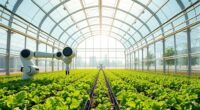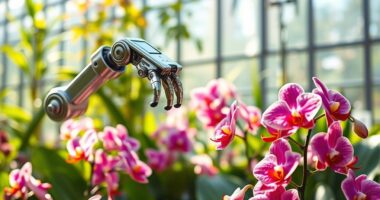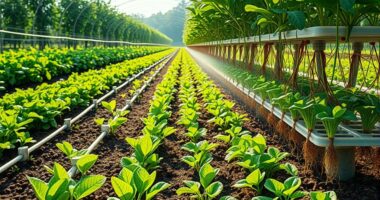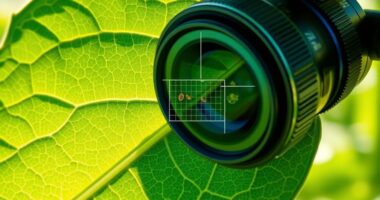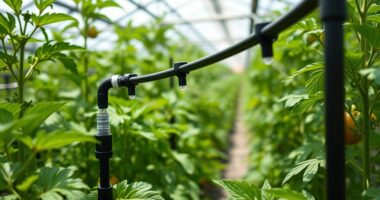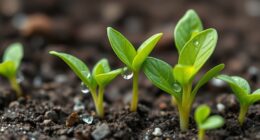Smart greenhouses use automation and IoT to optimize plant growth by controlling temperature, humidity, and light levels remotely. Sensors monitor environmental conditions continually, enabling automated adjustments to improve crop yield while reducing manual labor. Renewable energy sources like solar panels power systems efficiently, and IoT devices help monitor pests and optimize watering. If you want to explore how these advanced technologies can boost your crop production and sustainability, there’s more to discover ahead.
Key Takeaways
- IoT sensors and automated systems enable real-time environmental monitoring and adjustments for optimal crop growth.
- Renewable energy sources like solar panels power greenhouse operations, reducing costs and environmental impact.
- Automated pest detection and targeted control methods minimize crop damage and reduce chemical pesticide use.
- Climate and water systems are optimized through sensors and automation, enhancing resource efficiency and crop health.
- Overall, IoT and automation improve sustainability, crop quality, and reduce manual labor in smart greenhouse management.

Have you ever wondered how technology is transforming traditional farming? With the rise of smart greenhouses, you’re now part of a movement that maximizes plant growth through automation and IoT. These innovative structures are designed to optimize environmental conditions, making farming more efficient, sustainable, and less labor-intensive. Imagine controlling temperature, humidity, and light levels remotely, ensuring your crops thrive regardless of external weather changes. This precision becomes possible with connected sensors and automated systems that respond instantly to real-time data, giving you full control over your greenhouse environment.
One of the key advantages of smart greenhouses is their ability to harness renewable energy sources like solar energy. Solar panels installed on the greenhouse roof or nearby generate clean electricity, reducing reliance on traditional power grids and lowering operational costs. This sustainable energy source powers ventilation systems, irrigation, and automated lighting, ensuring your plants receive consistent care without increasing your carbon footprint. The integration of solar energy makes your greenhouse not only more eco-friendly but also more cost-effective in the long run, as you cut down on energy expenses and contribute to environmental conservation.
Pest control is another critical aspect managed seamlessly within a smart greenhouse. Using IoT devices, you can monitor pest activity and environmental conditions that attract pests, such as humidity and temperature levels. Automated pest detection systems alert you immediately when an infestation occurs, allowing for rapid response that minimizes crop damage. Some systems even employ targeted, environmentally friendly pest control methods like precision spraying or biological agents, reducing the need for chemical pesticides. This approach not only shields your plants from pests efficiently but also ensures the safety and quality of your produce, making your farm more sustainable and health-conscious.
In addition to energy and pest management, smart greenhouses leverage automation to optimize watering schedules based on soil moisture sensors, reducing water waste. Climate control systems adjust ventilation and shading automatically, maintaining ideal conditions for each crop. These interconnected systems gather data continuously, analyze trends, and make adjustments without manual intervention, freeing you to focus on other aspects of your farming operation.
Frequently Asked Questions
What Are the Initial Costs of Setting up a Smart Greenhouse?
When you ask about the initial costs of setting up a smart greenhouse, consider that your cost estimation includes equipment expenses like sensors, automation systems, and climate controls. These costs can vary based on the size and sophistication of your setup. You’ll need to budget for installation and possible infrastructure upgrades. Overall, expect a range from moderate to high, depending on your goals and the level of automation you want to implement.
How Secure Is Data Collected by Iot Devices in Greenhouses?
Did you know 60% of IoT devices face cybersecurity threats? When it comes to data privacy, your greenhouse’s IoT data isn’t automatically secure. You need strong cybersecurity measures like encryption and regular updates to protect sensitive information. While IoT offers great benefits, staying vigilant against cyber threats ensures your data remains safe and your operations run smoothly. Proper security practices are essential for safeguarding your greenhouse’s valuable data.
Can Smart Greenhouses Operate in Extreme Weather Conditions?
You might wonder if smart greenhouses can handle extreme weather conditions. With advanced weather resilience features and environmental adaptation technology, they’re designed to protect crops from harsh elements like heavy rain, snow, or high winds. These systems automatically adjust climate controls, insulation, and shading. So, yes, smart greenhouses can operate effectively in tough weather, ensuring ideal growth regardless of environmental challenges.
What Maintenance Is Required for Iot Systems in Greenhouses?
Think of your IoT system as a garden needing regular tending. You should regularly calibrate sensors to guarantee accurate readings and perform software updates to keep everything running smoothly. Just like pruning helps plants grow better, these maintenance tasks prevent glitches and improve efficiency. Staying on top of sensor calibration and updates keeps your greenhouse’s automation reliable, so your plants thrive without unexpected hiccups.
How Scalable Are Smart Greenhouse Solutions for Large Farms?
When considering scalability challenges for large farms, you find that smart greenhouse solutions can support farm expansion effectively. These systems are designed to grow with your needs, offering modular setups and cloud-based management that handle increased data and automation demands. While initial investments and integration complexity pose challenges, the long-term benefits include improved efficiency and yields, making it feasible to scale up without sacrificing control or productivity.
Conclusion
Imagine your greenhouse as a symphony, with automation and IoT as the skilled conductors guiding every note for perfect harmony. By embracing smart technology, you transform your growing space into a thriving, self-regulating ecosystem where plants flourish effortlessly. This new era of precision farming empowers you to nurture your crops with confidence, turning complexity into a seamless melody of growth. With innovation at your fingertips, you’re not just growing plants—you’re cultivating the future.

